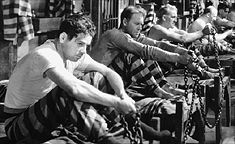Articles
The Social Criticism of I Am a Fugitive From A Chain Gang
Posted by Jennine Lanouette on Monday, December 24th, 2012
Reprinted from Release Print Magazine, Online Supplement, Special Focus on Media Activism, July/August 2004
In the summer of 2004, Release Print Magazine asked several writers and filmmakers to write about a film, filmmaker or media event that influenced their own work, sparked a movement, or illuminated a social justice issue. When I was approached, I immediately knew what film I would pick: Mervyn LeRoy’s 1932 I Am a Fugitive From a Chain Gang. Although from a distant past, this film still has much to teach us about speaking a social truth in the poetic language of drama.
 One day back in graduate school, I walked into Andrew Sarris’s American Film History class and encountered a film I knew little about, but whose title had always struck me as sounding rather cheesy, I AM A FUGITIVE FROM A CHAIN GANG. Expecting campy, farcical diversion at best (just the week before, after all, we had seen GOLD DIGGERS OF 1935) or over-the-top melodrama at worst, I settled into my lecture hall seat wondering what Sarris was up to. What unfolded in front of me was perhaps the most compelling and effective film of social criticism I have ever seen.
One day back in graduate school, I walked into Andrew Sarris’s American Film History class and encountered a film I knew little about, but whose title had always struck me as sounding rather cheesy, I AM A FUGITIVE FROM A CHAIN GANG. Expecting campy, farcical diversion at best (just the week before, after all, we had seen GOLD DIGGERS OF 1935) or over-the-top melodrama at worst, I settled into my lecture hall seat wondering what Sarris was up to. What unfolded in front of me was perhaps the most compelling and effective film of social criticism I have ever seen.
Out-of-work war veteran James Allen (Paul Muni) is tricked into participating in a restaurant holdup for which he is sentenced to ten years of hard labor on a Georgia chain gang. The conditions are brutal and Allen escapes. He goes to Chicago where he fulfills his dream of becoming a civil engineer building bridges and roads. But his landlady learns of his past and forces him to marry her. When he falls in love with another woman and asks for a divorce, she turns him in. The Georgia governor promises to pardon him. But instead, he is sent back to the chain gang from which he escapes a second time. In the final scene, he visits his beloved but is too flinching and paranoid to stay long. The film ends with a devastating line of dialogue that I will not reveal here so as not to deprive those who haven’t seen the film of the shocking effect it had on me.
I then learned from Sarris that the film, considered a hallmark of the Warner Bros. “social consciousness” films of the thirties, was based on the autobiography of Robert E. Burns, and had led to the reform of the Georgia chain gang system. At that point (the early ‘80s), it was the only known example of a dramatic film managing to effect concrete social change. This distinction inspired me to study the film and its sources in more depth.
Over years of continually referring back to CHAIN GANG, it has become clear to me that its strength is in the careful balance it manages to achieve between the foreground personal story of James Allen and the background societal story exposing and criticizing the chain gang system. James Allen’s personal story engages us in the drama, but the context in which he is presented is what teaches us the wider social significance of his circumstance. To create this revelatory context, the film story takes some dramatically important departures from the real life story on which it is based.
For one example, Burns, the real fugitive, was not a decorated war hero as portrayed in the film but a shell-shocked, broken man, and was by some accounts a more willing participant in the robbery than the film’s James Allen. Clearly, the war hero choice is dramatically motivated, making the character more unassailable in his later victimhood. But it also provides the opportunity for one of the more stark uses of imagery when, at the beginning, the down-and-out Allen tries to pawn his war medals and the pawn broker points to a display case full of war medals, as if pointing to a dustbin of forgotten war heroes.
Similarly, where Allen is an engineer in his underground life, Burns was a real estate man who became an editor and publisher of a real estate trade magazine, while also a respected civic leader as indicated in the film. Cinematically, the occupation of engineer enables more visually arresting scenes of Allen presiding over bridge building sites rather than bent over a typewriter. But again, it also elevates the film to a metaphorical level with Allen, the escaped convict, becoming visibly constructive in his new citizenship. This metaphor is then played out when, on his second escape, Allen must blow up a bridge in order to prevent his pursuers from overtaking him, being reduced to destroying that which he intended to devote his life to creating.
On the one hand, a straight telling of Robert Burns’s story would not have had the same dramatic thrill as his method of escape the second time was by bribing a local farmer to hide him in his truck. Sacrificed to truth would have been the tension-filled dump-truck hijacking and chase, culminating in a climactic explosion on a bridge. But by making dramatic choices, the filmmaker also achieved the broadening of the film story which could speak to the plight of all forgotten war veterans trying to get by, and to the justice system’s potential to lay waste to the most well-intentioned of human endeavors.
